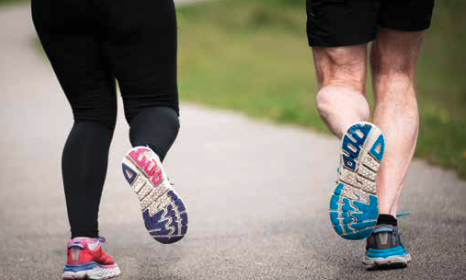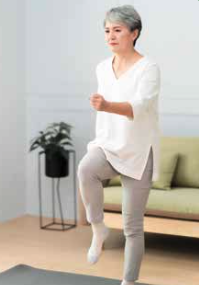|
29/6/2022 0 Comments Running for your lifeDo you love to jog? Are you a runner at heart, or are you yet to hit the track? Either way it’s important to know how to keep yourself healthy and injury-free.Running (or jogging) offers physical and psychological benefits − both your body and mind will thank you for the effort. And while you might feel nervous about taking up − or continuing − the practice, most of the research is positive. The reported benefits are great; pounding the pavement can help you to live a healthier, happier life.
On the physical side, regular practice improves fitness. Running is a weight bearing exercise and will strengthen your bones and muscles. It can protect against cardiovascular problems and lower your risk of an early death. It can also help you shed unwanted kilos; a 2014 study published in the journal, Medicine & Science in Sports & Exercise, found that running was more beneficial than walking for your waistline. On the psychological side, running can improve mental health. Symptoms of anxiety and depression, stress, and mood have been shown to improve. Creativity and higher self-esteem have been found to increase. Reduced feelings of aggression and anger have been reported, as has enhanced emotional well-being and happiness. But, like any form of exercise, soreness and injuries can and do occur. Which raises the question: Is jogging and running safe for our bodies? Yes, with the right approach and care. Start slowly − try jogging at a low intensity for one minute, then switch to walking for three to five minutes. Repeat this cycle for 15 - 20 minutes, three times a week. As your fitness improves; build intensity and running duration gently and gradually. But remember: if your body says stop... stop! It’s always better to be safe and get professional advice. If you have pre-existing injuries, conditions, or risk factors, it’s wise to obtain advice before you begin. How can chiropractic help? We can restore healthy motion to the joints of your spine and extremities. This helps to correctly distribute pressures through your body, such as those exerted when jogging and running. We can also assess your posture and technique; the way your feet hit the ground, and other factors important to this exercise. We can provide advice and help correct what’s needed. We look forward to supporting you as you lace up your running shoes and head on out!
0 Comments
AGEs stands for advanced glycation end products, which are harmful compounds that are created when protein or fat combines with the sugar in our blood. We make AGEs naturally in our bodies – but an excess is harmful and most of that comes from our diet.The modern diet is thought to be partly to blame for increases in the incidence of many chronic diseases. If you regularly cook certain foods with dry heat and at a high temperature − such as frying, roasting and barbecuing − or eat large amounts of processed foods, your AGEs level is probably high.
Fortunately, your body is designed to get rid of AGEs, however when you consume too many your body can’t keep up with eliminating them, and they accumulate. This can have serious effects on your health. Why are AGEs a problem? AGEs increase oxidative stress, causing an imbalance in the body’s natural process of keeping itself healthy. In the long-term this can lead to inflammation and cell and tissue damage, contributing to an increased risk of a wide range of diseases. Serious chronic conditions like heart disease, type 2 diabetes, kidney disease, cancer, and some forms of dementia are more common in people with higher levels of AGEs in their body. Reducing AGEs in your diet Changing the way you cook is a good start, cooking food slowly and keeping it moist helps limit AGEs. A slow cooker is a useful (and tasty) way of cooking. Cooking high fat, high protein foods creates more AGEs than cooking low-fat plant-based foods, even at the same temperature. Avoid foods which are high in AGEs, particularly high protein animal foods like meat and high fat dairy products. Margarine, oils, and nuts also produce high levels with heat. The highest level of AGEs is in processed foods (e.g. chips, crackers, and biscuits) due to the dry cooking methods as well as the ingredients. Eating food that’s high in antioxidants not only reduces your overall intake of AGEs, but helps your body get rid of those that you take in from other sources. Following a healthy diet rich in fresh, raw fruit and vegetables; and whole grains and legumes, will reduce your intake of AGEs, improving your overall health in all kinds of ways! Long haul flights and lengthy road trips can harm your back. Sitting in a cramped position for hours takes a toll on your spine. There’s also your luggage; carrying and lifting heavy bags can hurt your back.As we begin to journey again, now’s the ideal time to plan for a better back. Here are five ways to keep your back healthy and comfortable.
1. Stay hydrated When driving or flying long distances, you may be tempted to limit your fluid intake. After all, this means fewer toilet breaks. But being dehydrated can increase your sensitivity to pain. Drink water regularly to stay hydrated and protect against discomfort. 2. Pack sensibly, lift carefully. Most of us pack more than we need for a holiday. Keep bag weights as light as possible. When lifting, use the correct technique. Squat and brace your legs — not your back — to lift. Maintain an upright spine. Keep items close to your body. Pivot with your feet, don’t twist. Take your time. 3. Wear a thick scarf. A scarf is easy to wear and has multiple uses. If you’re stuck without lumbar support, place a rolled scarf in the curve of your lower back. If your neck feels unsupported, use a rolled scarf behind it. If you experience coccyx pain, sit on a folded scarf to lessen the discomfort. And, of course, a scarf can keep you warm too! 4. Move often. Plan how you can keep moving during your trip. When you’re on a long flight, opt for an aisle seat so you can easily stand and move about. When you‘re driving a long distance, schedule regular stops to shake out your body. Whether flying or driving, aim to stretch and move often. Shrug your shoulders, extend your legs, tilt your neck from side to side. 5. Pack the heat. Snap-to-work hot packs and heat patches make great travel companions. Easy to transport and use, they provide comforting warmth just where and when it’s needed. We can provide customised advice on how to keep your back safe before you travel. 29/6/2022 0 Comments Is yoga good for you?Yoga has taken the world by storm, but how do you know this practice is good for you? What are the benefits, and how can you stay safe?Research shows there are a multitude of health benefits for both mind and body.
A 2017 study published in the International journal of Yoga Therapy found that a 10- week program eased stress, improved depression, and increased self-awareness. Other research showed potential relief from the symptoms of anxiety. Mindfulness and self-compassion also improve with two or more sessions per week. On the physical side the benefits are broad; research shows regular yoga increases flexibility and strength, and promotes greater healing from discomfort or injury. A 2016 study published in the Journal of Orthopaedic Rheumatology investigated yoga in relation to chronic low back pain. Regular practice lessened pain, decreased disability, was ‘do-able’ and safe. But, like any exercise, intensity matters. Everyone needs to train to build physical strength and stamina. This is the same for yoga. A beginner must begin at a beginner’s level, but with time and practice bodies change, and you’ll find your level of fitness and ability improves. So, can certain yoga positions be harmful? Yes, pain, soreness and injuries can occur. Naturally! Like starting at a gym, yoga may temporarily cause tenderness. Pushing too hard, too soon can cause injuries. If you’re a yoga beginner, it’s wise to start slowly. There’s no need to keep up with others. If a pose hurts, stop. Seek advice before continuing. Soreness doesn’t mean you shouldn’t practice; there may simply be a better way to position yourself, for now. If you are already under our care for back pain, please ask us whether yoga is suitable for you. Adapting your practice may be all you need to reap the many benefits of yoga. 29/6/2022 0 Comments Are your knees letting you down?Do your knees ache or feel stiff when you wake or sit too long? Do you have an old or new injury? If the answer is yes, you’re not alone − around one in three people experience knee pain. Yet, while knee pain is common, many treatments can be unhelpful. With this in mind, what is the chiropractic perspective?Knee pain can result from a variety of conditions and factors. Ligament tears, torn cartilage, arthritis, or faulty mechanics may each be a cause. Problems in other parts of your body can alter how it functions and also trigger discomfort. In addition, your knee is complex; it can be difficult to find the exact source of soreness.
The knee consists of the tibia (shin bone) and femur (thigh bone), plus the fibula and the patella (kneecap). Cartilage sits between the femur and the tibia to absorb shock, and the cruciate ligaments connect these bones. They stabilise and stop excess forward and backward movement. There are smaller ligaments that help to hold the knee together. The hamstrings and quadriceps deliver movement. Each of these parts, and more, need to work together for the knee to function well. If your feet, ankles, hips, pelvis and low back function incorrectly, your knee can be affected. For example, many chiropractors find that a low back problem can manifest as knee discomfort. Think about it this way: if the knee is like the floor of your home, movement of the foundations or the walls can cause it to crack. Likewise, joints below or above the knee can contribute to its dysfunction and discomfort. How might chiropractic care be beneficial? Chiropractors diagnose and help to restore and heal faulty biomechanics. Whether in the lower limbs — at the knees, hips, ankles, and feet — or within the spine and pelvis, we help ‘take the pressure off’ to allow your body to recover. As your joints regain healthy function, your knee may recover too. |
AuthorAdam's Back is a team of dedicated complimentary health professionals. Our aim is to support you in finding drug-free solutions for better health. Archives
July 2024
Categories |
Search by typing & pressing enter






 RSS Feed
RSS Feed